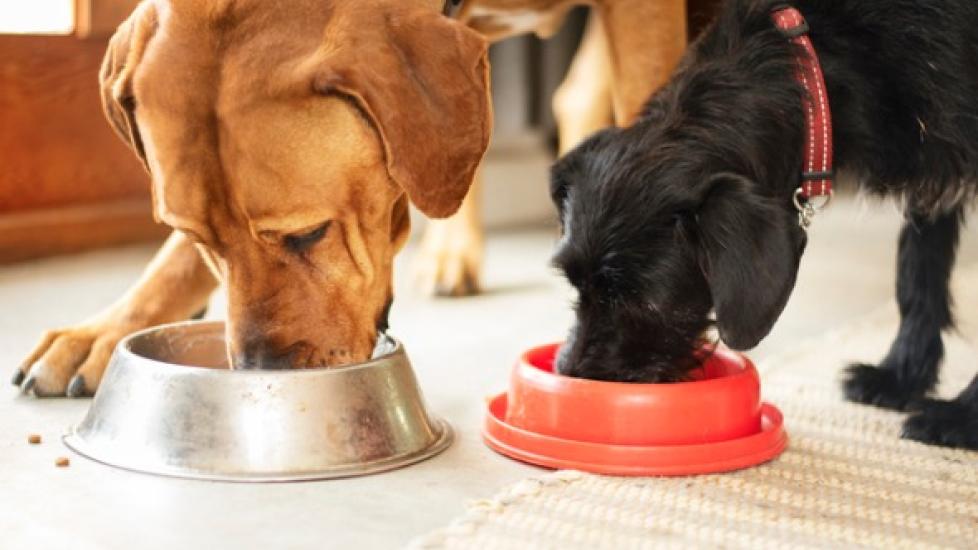Dry Dog Food vs. Wet Dog Food: Which Is Better?
The number of dog food products on the market can make it very confusing for you to choose a diet that is appropriate for your pet. Not only are there tons of different brands and ingredients, but even the most basic choice of wet versus dry dog food can be overwhelming.
It’s important to always consult your veterinarian for more specific recommendations that best fit your dog’s lifestyle, but this article will go over the main differences between dry and wet dog food.
What's the Difference Between Wet and Dry Dog Food?
Both dry dog food and wet dog food can provide nutritionally balanced diets, but the major difference is in the way they are processed.
How Is Wet Dog Food Processed?
Wet food starts with grinding the protein sources, or meat ingredients. Then a gravy that contains vitamins, minerals, and grains is added. Once those are mixed, the food is cooked and sterilized to produce the canned product.
As a result, wet food has a much higher moisture content than dry food. You can see the percentage of maximum moisture on the label, under the Guaranteed Analysis section. A dry food might have around 10% moisture (max.) while a wet food might have something like 78% moisture (max.).
How Is Dry Dog Food Processed?
Dry food contains very similar ingredients, but instead of adding gravy and canning the product, the meat mixture is pulverized in order to create a consistent dough that can be cooked.
Once cooked, the dough is extruded through specifically shaped holes to form kibble. The kibble undergoes a drying process, and then is sprayed with fats, oils, vitamins, and minerals and packaged before the fats and oils can spoil.
Some dry dog food diets also add live probiotics to aid in digestive and immune health.
Is Wet or Dry Food Better for Dogs?
Both types of dog food are good choices, but each has their own benefits and drawbacks depending on the nutritional needs of your pet.
Benefits of Wet Dog Food Compared to Dry Dog Food
Wet dog food, or “canned food,” sometimes provides benefits that dry food doesn’t offer, such as:
-
Higher moisture content: Wet food may be a good choice if your dog doesn’t drink as much as they should, or if they have a medical condition that could benefit from proper hydration. One example would be a dog with a history of urinary or kidney disease.
-
Palatability: Canned dog food is often more aromatic and flavorful when compared to dry food. This may entice sick or older dogs to eat if their appetite is decreased.
-
Satiety: Wet dog food tends to create a longer-lasting feeling of being “full.” Increased satiety is useful in weight management, especially in dogs that seem to have a never-ending appetite.
-
Easier to chew: Dogs that have dental disease or other oral abnormalities may find wet food easier to chew than dry food.
Benefits of Dry Dog Food Compared to Wet Dog Food
Dry dog food, or “kibble,” often offers certain benefits that wet food doesn’t provide, such as:
-
Dental health benefits: Dry food encourages dogs to chew their food, which aids in preventing tartar buildup and secondary periodontal disease.
-
Convenience: Compared to wet food, dry diets are much easier to pre-portion, and they won’t spoil if left out all day. This can be beneficial for dogs that are grazers.
-
Financially feasible: Depending on the brand of food, dry diets may be less expensive to purchase and store long-term.
-
Food enrichment: Kibble is easier to integrate into food puzzles and slow feeders that may improve a dog’s quality of life through cognitive stimulation.
What Wet Dog Food Do Veterinarians Recommend?
When choosing any type of dog food, it is always helpful to have your pet’s needs in mind, and to learn how to effectively read a pet food label.
The most commonly recommended dog food brands, by veterinarians, include: Royal Canin®, Science Diet®, and Purina Pro Plan®. Here are a few wet dog food options for puppies, adult dogs, and senior dogs:
What Dry Dog Food Do Veterinarians Recommend?
The most commonly recommended dry dog food brands, by veterinarians, are the same as for wet food: Royal Canin®, Science Diet®, and Purina Pro Plan®. Here are a few dry dog food options for puppy, adult, and senior life stages:
Guide to Mixing Wet and Dry Dog Food
Mixing wet and dry dog food is another option that may provide the best of both worlds. However, it is very important to ensure you are still providing the proper daily feeding amount to prevent overfeeding.
The best way to do this is to have your local vet calculate your furry friend’s daily calorie requirements for maintenance. Then you can calculate how much dry and wet food your dog should have each day to reach that number of calories—and don’t forget to factor in any calories from treats.
Featured image: iStock.com/NickyLloyd
